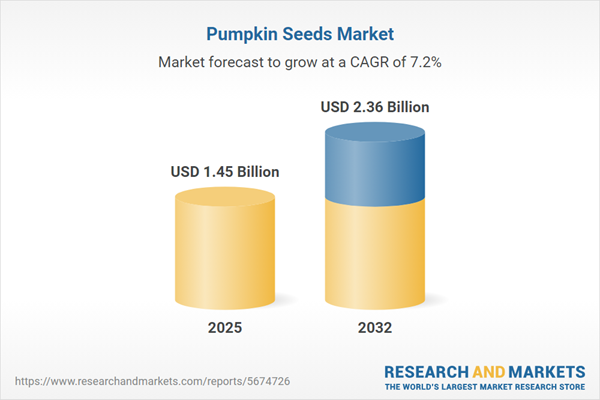Speak directly to the analyst to clarify any post sales queries you may have.
The pumpkin seeds market is evolving rapidly, creating far-reaching implications for senior executives seeking clear guidance on plant-based nutrition trends, supply strategy resilience, and emerging sustainability measures. Timely insights equip decision-makers to anticipate and act on industry demands, secure effective procurement solutions, and maintain robust organizational agility within a shifting global landscape.
Pumpkin Seeds Market Snapshot: Size, Growth, and Key Trends
In 2024, the global pumpkin seeds market was valued at USD 1.35 billion and is projected to reach USD 1.45 billion by 2025, with long-term growth expected to achieve USD 2.36 billion by 2032. The compound annual growth rate (CAGR) stands at 7.18%. Driving forces include an expanding focus on nutritious, plant-based foods, wellness initiatives, and a broader industry pivot to sustainability. Companies are responding by innovating across snack, bakery, and functional food categories, using diversification in product formats to align offerings with evolving consumer preferences. Secondary keywords such as "healthy snacking" and "traceable sourcing" underscore the importance of integrating these trends to capture market share.
Scope & Segmentation of the Pumpkin Seeds Market
- Form: Flavored, organic, raw, roasted, and salted pumpkin seeds support product variety, enabling brands to serve both premium and mainstream healthy snacking needs across regions.
- End User: Key buyers include manufacturers in the snack, bakery, and confectionery sectors, along with retailers and direct-to-consumer channels, each necessitating tailored procurement and customer engagement strategies.
- Application: Pumpkin seeds are widely used for healthy snacking, bakery and confectionery development, and as functional ingredients in next-generation products, aiding companies in differentiating offerings in crowded markets.
- Packaging: Bulk packaging such as bags and barrels enables efficient high-volume purchases, while shelf-ready formats like pouches, jars, and boxes enhance logistical efficiency and visibility at retail.
- Distribution Channel: Distribution spans convenience stores, specialty outlets, supermarkets, hypermarkets, and e-commerce, aligning with omnichannel strategies to maximize reach and adaptation to digital commerce trends.
- Geographical Coverage: The market encompasses the Americas, Europe, Middle East & Africa, and Asia-Pacific, with the United States, Canada, Brazil, United Kingdom, Germany, China, and India shaping international demand and influencing new product development pipelines.
- Company Coverage: Notable participants include Archer Daniels Midland Company, Cargill, Bunge Limited, John B. Sanfilippo & Son, PepsiCo, The Kellogg Company, Conagra Brands, Calbee, Utz Brands, and Hain Celestial Group, each driving sector innovation and partnership growth to help customers meet dietary and regulatory requirements.
Key Takeaways for Strategic Decision-Makers
- Broadening product portfolios with plant-based and functional options drives competitive positioning across diverse food sectors keen to capture emerging demand for natural ingredients.
- Prioritizing clean label and flavor innovation elevates brand credibility and supports value capture in premium and wellness-oriented segments.
- Implementing new processing and packaging technologies not only improves shelf appeal but also increases cost efficiency throughout the retail and foodservice supply chain.
- Customizing entry strategies for each region leverages local consumption dynamics, realizing additional growth while managing exposure to regional risks in established and emerging markets.
- Embedding ethical sourcing and traceability within procurement fosters transparency, building long-term trust with business clients and supporting compliance objectives.
Pumpkin Seeds Market: Assessing Tariff Impact
With the upcoming United States tariffs on imported pumpkin seeds in 2025, importers and domestic processors are reviewing sourcing and procurement strategies. Actions include expanding partnerships with local growers, diversifying supplier bases, and investing in domestic processing capabilities. These approaches are designed to help maintain profit margins and business continuity during regulatory and trade policy shifts.
Methodology & Data Sources
Research methodology combines structured interviews with supply chain stakeholders, including pumpkin seed growers, processors, manufacturers, and distributors, enhanced by secondary research from industry and regulatory sources. Validation uses triangulation and cross-references with recognized sector databases, ensuring findings meet the accuracy and reliability standards needed by senior executives.
Why This Report Matters: Actionable Insights for Senior Executives
- Supports proactive capital allocation and resource planning as consumer preferences shift, enhancing procurement efficiency across operations.
- Clarifies evolving tariff and regulatory environments, providing a clear framework for compliance and forward-looking decision-making.
- Offers segmentation analysis and targeted recommendations on technology adoption in development, logistics, and packaging to drive sustainable growth.
Conclusion
Staying informed on sector developments and responding with nimble strategies allows businesses to create long-term value and build resilience, ensuring sustainable competitive advantage in the evolving pumpkin seeds market.
Additional Product Information:
- Purchase of this report includes 1 year online access with quarterly updates.
- This report can be updated on request. Please contact our Customer Experience team using the Ask a Question widget on our website.
Table of Contents
3. Executive Summary
4. Market Overview
7. Cumulative Impact of Artificial Intelligence 2025
List of Figures
Samples

LOADING...
Companies Mentioned
The key companies profiled in this Pumpkin Seeds market report include:- Archer Daniels Midland Company
- Cargill, Incorporated
- Bunge Limited
- John B. Sanfilippo & Son, Inc.
- PepsiCo, Inc.
- The Kellogg Company
- Conagra Brands, Inc.
- Calbee, Inc.
- Utz Brands, Inc.
- Hain Celestial Group, Inc.
Table Information
| Report Attribute | Details |
|---|---|
| No. of Pages | 192 |
| Published | October 2025 |
| Forecast Period | 2025 - 2032 |
| Estimated Market Value ( USD | $ 1.45 Billion |
| Forecasted Market Value ( USD | $ 2.36 Billion |
| Compound Annual Growth Rate | 7.1% |
| Regions Covered | Global |
| No. of Companies Mentioned | 11 |









